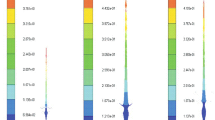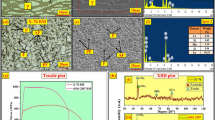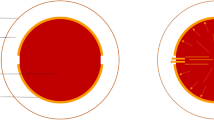Abstract
Shaped charges are unique and very effective warhead technology mostly applied to the rocket propelled grenades (RPGs) along with other applications (e.g. perforation of rocky formations in mining, rock drilling and other geological technics etc.). RPG’s armour piercing and perforation performances originate from an explosively induced formation of a stretching metallic jet with very high velocities (hypervelocity). The hydrodynamic penetration mechanism of the stretching quasi-solid metallic jet is extremely complex and has not been fully understood. Both the jet with spout-like form and the target (i.e. RHA armour steel) behave hydrodynamically (i.e. incompressible fluid) and yet both solid strangely. The present study, as part of a large-scale customized R&D project, is stopping the penetration of the stretching jet of a RPG rocket within an “add-on” armour system. A series of experimental detonations and explosion of shaped charge munitions was conducted to elucidate the microstructural evolution and microstructural features of the metallic copper jet. Penetrating metallic spout-like jet forms were stopped and apprehended/caught within the inner layers of highly succesful composite based “add-on” armour designs. Structural evolution and microstructural analysis of the penetrating metallic jet were investigated to understand this extraordinary “solid-but behaving like fluid (quasi-solid)” metallic copper jet material. The findings obtained in this study suggest that the effective way of stopping the lethal effects of this weapon could be managed by diverting and/or twisting its linear stretching and penetration pathway.











Similar content being viewed by others
References
W. Walters, Introduction to Shaped Charges, U.S. Army Research Laboratory ATTN: AMSRD-ARL-WM-TC Aberdeen Proving Ground, 2007
A.I.H. Fayed, Y. A. Abo El Amaim, and Doaa H. Elgohary, Investigating the Behavior of Manufactured Rocket Propelled Grenade (RPG) Armour Net Screens from Different Types of High Performance Fibers, Int. J. Sci. Res., 8(5), 2019
P. Zochowski and P. Podgórzak, Numerical Analysis of Effectiveness for Vehicle Net Systems Protecting Against Shaped Charge Projectiles, Problemy Techniki Uzbrojenia, 2016, 139(3), p 23–37. https://doi.org/10.5604/01.3001.0010.0533
M. Szudrowicz, Material Combination to Mitigation of Behind Armour Debris After Shaped Charge Jet Attack, in 17th International Conference Diagnostics of Machines and Vehicles MATEC Web of Conferences, Vol. 182, p. 02009, 2018, https://doi.org/10.1051/matecconf/201818202009
B. T. Burch, Determining and Mitigating the Effects of Firing a Linear Shaped Charge under Water, Masters Theses. Missouri University of Science and Technology, 7305, 2014. https://scholarsmine.mst.edu/masters_theses/7305
W. P. Walters, An Overwiew of the Shaped Charge Concept, Department of Mathematical Sciences,US Military Academy,West Point, 1990. http://www.Walters.PDF
Linear shaped charge warhead. https://patents.google.com/patent/US3934511A/en
V. Bohanek, M. Dobrilović and V. Škrlec, The Efficiency of Linear Shaped Charges, Tehnički vjesnik, 2014, 21(3), p 525–531.
H. Prentice and J.P. Curtis, Heat Generation by Shaped Charge Penetration, Int. J. Impact Eng., 2003, 29, p 589–600.
I.G. Aksoy and S. Şen, Effects of the Variation of Conical Liner Apex Angle and Explosive Ignition Point on Shaped Charge Jet Formation, Indian J. Eng. Mater. Sci., 2003, 10, p 381–389.
G. Cooke, M72 Light Anti-tank Weapon System (LAW). www.inetres.com. Gary's U.S. Infantry Weapons Reference Guide
R. Cornish, J.T. Mills, J.P. Curtis and D. Finch, Degradation Mechanisms in Shaped Charge Jet Penetration, Int. J. Impact Eng., 2001, 26, p 105–114.
J.F. Molinari, Finite Element Simulation of Shaped Charges, Finite Elem. Anal. Des., 2002, 38, p 921–936.
D. Liangliang, T. Wenhui and R. Xianwen, Simulation Study on Jet Formability and Damage Characteristics of a Low-Density Material Liner, Materials, 2018, 11, p 72. https://doi.org/10.3390/ma11010072
M. Held, Stopping Power of Explosive Reactive Armours Against Different Shaped Charge Diameters or at Different Angles, Propellants Explos. Pyrotechnol., 2001, 26, p 97–104.
M. Mayseless, E. Marmor, N. Gov, Y. Kivity, J. Falcovitz, and D. Tzur, Interaction of a Shaped Charge Jet with Reactive or Passive Cassettes, ın Proceedings of the 14th International Symposium on Ballistics (ISB 014), Quebec, QC, Canada, 26–29 September 1993.
B. Venkatesh and V. Madanmohan, Comparative Analysis of Arbitrary Lagrange in Eulerian (ALE) and Adaptive Smooth Particles Hydrodynamic (SPH) Simulation of Rocket Propelled Grenade (RPG) on Armours, in Conference: 31st International Symposium on Ballistics, Conference Paper December 2019. https://doi.org/10.12783/ballistics2019/33183
A.I. Kozachuk, A.A. Kozhushko, B.V. Rumyantsev, A.B. Sinani, A.S. Vlasov and F.L. Zilberbrand, On Interaction of Shaped-Charge Jets with the Crater Walls in Penetrating Metals and Brittle Materials, Int. J. Impact Eng., 2003, 29, p 385–390.
D. Palmieri, R. Destefanis, M. Faraud and M. Lambert, Penetration Effectiveness of Inhibited Shaped Charge Launcher Projectiles and Solid Spheres on Spacecraft Shields, Int. J. Impact Eng., 2003, 29, p 513–526.
U. Hornemann and A. Holzwarth, Shaped Charge Penetration in Alumina Targets, Int. J. Impact Eng., 1997, 20, p 375–386.
K.H. Kamarudin, A.M.A. Zaidi, S. Abdullah and Md.F.S. Koslan, Establishment of Shaped Charge Optimum Parameters for Small Scale Hydrodynamic Penetration, Mod. Appl. Sci., 2016, 10(1), p 1844–1852.
NATO AEP-55, STANAG 4569: A NATO Standardization Agreement Covering the Standards for the "Protection Levels for Occupants of Logistic and Light Armoured Vehicles". AEP-55, Volume 1, “Procedures for Evaluating the Protection Level of Logistic and Light Armoured Vehicles” 2005, NATO/PfP Unclassıfıed
Acknowledgments
Authors would like to thank to the State Planning Organization of Turkish Republic for the support of the Project. Authors would like to thank to the Tetra for their support for the SEM microstructural analysis and EDS studies. Authors would also thank to the researchers and technicians of the Materials Institute of TUBITAK Marmara Research Center for their support and work during the detonation-explosion experiments.
Author information
Authors and Affiliations
Corresponding author
Additional information
Publisher's Note
Springer Nature remains neutral with regard to jurisdictional claims in published maps and institutional affiliations.
Rights and permissions
About this article
Cite this article
Baykara, T., Günay, V. & Demirural, A. Structural Evolution and Microstructural Features of the Hydrodynamically Penetrating Copper Jet of a Shaped Charge. J. of Materi Eng and Perform 30, 1862–1871 (2021). https://doi.org/10.1007/s11665-021-05514-9
Received:
Revised:
Accepted:
Published:
Issue Date:
DOI: https://doi.org/10.1007/s11665-021-05514-9




